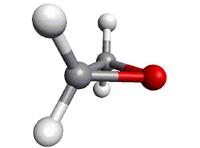|
The very limited data set of the first entry
from July 2012 was extended significantly by
measurements between 158 and 1084 GHz
by
(1) H. S. P. Müller, J. C. Guillemin, F. Lewen,
and S. Schlemmer,
2022, J. Mol. Spectrosc. 384, Art. No. 111584.
The initial experimental data were taken
from
(2) R. A. Creswell and R. H. Schwendemann,
1974, Chem. Phys. Lett. 27, 521.
Also used in the fit were microwave data
from
(3) C. Hirose,
1974, Bull. Chem. Soc. Japan 47, 1311.
Uncertainties of data from (2) were increased to 20 kHz
from 10 kHz because of the sizes of the average residuals.
Four transitions with large residuals from (3) were omitted.
The calculation should be sufficiently accurate for
all observational purposes. Calculated frequencies
with uncertainties exceeding 0.1 MHz
should be viewed with some caution.
At very low temperatures, it may be necessary to discern
between ortho-c-C2H418O
and para-c-C2H418O.
The ortho states are described by
Ka + Kc even,
the para states by Ka + Kc
odd. The nuclear spin-weight ratio is 5 : 3 for
ortho-c-C2H418O
: para-c-C2H418O.
The JKaKc = 101
is the lowest para state. It is 1.1925 cm–1
above ground. Because of this very small energy difference,
separate analyses are probably only required for absorption
transitions originating in the 101 level.
The dipole moment was assumed to agree with that of
the main isotopolog, taken from
(4) G. L. Cunningham Jr., A. W. Boyd, R. J. Myers,
W. D. Gwinn, and W. I. Le Van,
1951, J. Chem. Phys. 19, 676 ;
corrected by 0.02 D due to an updated reference
value for OCS, see (1).
|
